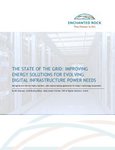In our increasingly digital world, data centers have become the beating heart of the global economy. These critical facilities store and process vast amounts of information, serving as the backbone for businesses, individuals, and government agencies alike.
Whether it's a financial institution executing billions of transactions daily, a tech giant streaming content to millions of users, or a government agency safeguarding critical national data, they all rely on data centers to keep their operations running smoothly.
However, this reliance comes with a catch ‒ the absolute necessity for data center uptime. Even a minor hiccup can lead to disastrous consequences, from lost revenue and productivity to compromised data integrity and damaged reputations.
Over 60 percent of data center power failures result in at least $100,000 in total losses, with 15 percent of outages costing upwards of $1 million. For customers like hospitals, lack of access to data can not only be expensive, but more importantly, it could be life-threatening.
Diesel generators have long been the go-to choice for backup power in data centers, despite their known limitations such as pollutant emissions and challenging fueling logistics.
However, as the competition for customers and investors grows fierce, reliability, availability, new revenue streams, community impact, and environmental footprint may end up being the deciding factor between a deal being signed or not.
This is amplified by growing corporate mandates to achieve carbon negative emissions, which can be more difficult to achieve while utilizing diesel technologies. Data center operators can move beyond diesel generators, instead utilizing proven, affordable, and available natural gas resources, to ensure that their backup power strategies are a strength, not a liability.
Reliability
In the face of the increasing prevalence of long-term outages, natural gas generators are proving to be more reliable than diesel generators. Although the level of reliability is similar over the first 48 hours of an outage, once the first tank of diesel is depleted, the need to swap out fuel sources adds complexities for diesel that do not exist with natural gas.
Diesel generators are also known to experience problems when not in use for extended periods. This is because diesel fuel can become contaminated or degraded over time. Natural gas generators have no such problems because the gas remains in its natural, stable state. Natural gas generators are also easier to start and operate, even in cold temperatures, making them more reliable for emergency power outages while still meeting ISO 8528-5 standards.
For example, during Winter Storm Uri, many Texans turned to the only building in their community that maintained power for shelter – the local H-E-B grocery store. Because H-E-B was equipped with a natural gas microgrid, they were able to continue their operations, providing food, water, and other essential services for their neighbors in need.
Availability
The availability of natural gas backups tends to be higher than that of diesel fuels. Diesel fuel is not easily available in times of emergency, given the unique conditions required for storage and transportation, which can generate uncertainties. However, natural gas is readily available through existing infrastructure, pipelines, and utility companies, ensuring that data centers have access to a stable backup energy source in times of emergency.
New revenue streams
In terms of cost, natural gas backup generators do tend to cost more to operate than diesel. However, these operating costs can be drastically reduced over the lifespan of the generator through their ability to sell power back to the grid.
By equipping data center facilities with microgrid systems, they can become distributed energy resources (DERs), capable of reacting to grid conditions in real time to help mitigate outages and grid stress than can cause outages.
During times when grid strain is high, these microgrids can feed power back into the grid, not only reducing demand, but actually increasing supply. This will provide much needed relief to the grid, as the microgrid supports the local utility in meeting the needs of its customers.
As an additional benefit to the data center, it can be financially compensated for these energy sales, thus turning its role as a DER into an additional revenue stream.
Community impact
Diesel generators produce harmful local emissions such as nitrogen oxides, carbon monoxide, and particulate matter that can harm the environment and human health. Natural gas generators, on the other hand, produce fewer local emissions and are better for the environment, including the communities in which they operate.
Natural gas generators also generally operate more quietly than diesel generators. While this might not be a critical factor for all data centers, it can be beneficial in urban areas or other noise-sensitive environments.
As data centers increasingly move closer to the customers they service, it’s important for them to maintain their licenses to operate. If a community is unwilling to allow a disruptive, loud facility into their neighborhood, they may look to one with quieter operations instead.
Environmental footprint
Natural gas can have a lower carbon footprint than diesel. Additionally, by utilizing renewable natural gas (RNG) as fuel, microgrids can achieve carbon neutrality or even negative emissions. In contrast, diesel will always have a positive carbon impact score, and would be incapable of reaching carbon neutrality.
For example, some natural gas microgrids can outperform current California Air Resources Board emissions requirements for distributed generation, the most stringent in the world, with hourly local emissions 80-96 percent lower than Tier IV diesel standards.
As data center customers and investors look to reduce their scope 1, 2 & 3 emissions to meet their sustainability goals and targets, they are increasingly turning to data centers that can showcase their commitment to reducing their environmental impact.
As data centers strive towards greener and more reliable operations, natural gas microgrids are emerging as the ideal choice. Natural gas generators offer significant advantages including greater reliability, availability, new revenue streams, reduced community impact, and lower environmental footprint.
Now is the perfect time for operators to lead in this transition, standing out from the competition and utilizing the benefits of natural gas to earn an edge over those who still rely on diesel.
More from Enchanted Rock
-

Sponsored Data centers as good grid citizens
How microgrids can turn facilities into welcome members of the community
-

Sponsored Debunking natural gas myths
The part natural gas has to play in fueling the future
-

Enhancing resiliency for the energy transition
Understand the critical role and benefits of dual purpose resiliency microgrids


